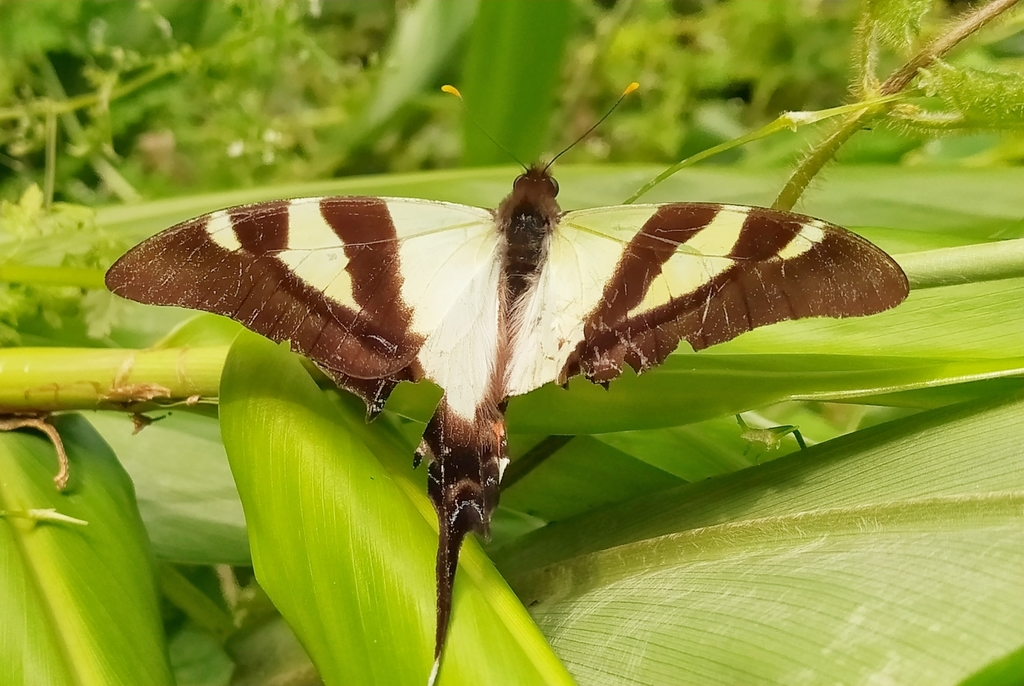Eurytides columbus, the Colombian Kite or Columbus Kite, is one of those butterflies about whom a data search can be quite infuriating. Nobody knows very much about the Colombian Kite--why it lives in only a few parts of Colombia and Ecuador, what it lives on, whether it may become useful to humans, whether it is in fact a distinct species--except that it's rare, and so, knowing nothing about how fragile or robust a species it is, people will sell you dead bodies. Or they'll take your money and say they're sending you dead bodies.
Hiss. Spit! Boxes of dead bodies aren't going to tell us anything Walter Rothschild didn't know in 1910. Why don't these people show a little initiative and find out some facts about these butterflies' lives?
Modern technology gives us better ways to study butterflies than pinning dead bodies in boxes. The good news is that some of the photos and videos that tell us what we know about columbus are free to enjoy on the Internet. Facts about this butterfly are harder to find than pictures of it are. Its picture has even appeared on postage, like this Liberian stamp:
As shown, it's small compared with some butterflies in the Swallowtail family, but larger than some other Kites; if the individual shown is sitting on an average man's hand its wingspread is about four inches. As with many Swallowtail species, colors vary, individuals tending to fade; newly eclosed Columbus Kites iridesce a fantastic mix of yellowish and bluish green with black stripes, older ones fade to black and white or brown and yellow. The body is black and furry; the eyes may reflect white or blue in some lights, and the antennae have bright yellow tips, curved backward like little golf clubs. The leading edge of the forewing has a decided curve, Overall, it looks different enough from the last few Kites we've seen to explain why some scientists think it belongs in a separate genus.
The Columbus Kite fits within the tradition of naming Swallowtails after heroes. In fact this species received one of the more logical names in the "heroes" category; it lives in a country that was named after a hero of the country's history, and it shares that hero's name. Nevertheless, some question remained whether columbus should be classified as a completely distinct species, or as a subspecies, of the more widespread Eurytides serville. In any case, columbus and serville are in the minority of species in the genus Eurytides that nobody is trying to rename Protographium, or maybe Neographium.
In Spanish the Kites are called Cometa, just as the kites people fly are called cometas. In English these long-tailed Swallowtail butterflies are sometimes called Swordtails, like the even longer-tailed Swordtails in the genus Graphium.
Though rare, worldwide, they don't seem to be endangered; the norm for Kites is, after all, to live in symbiosis with one food plant, the total number of butterflies in the species alive at any given time fairly constant, dependent on the number of food plants. Most pollinate native fruit trees. Though each of these butterflies may turn out to be as important as the Zebra Swallowtail is to humans, they do live in countries where few people have felt able to afford to spend days watching butterflies. What a pity that sales for students' photographs and journals aren't as profitable as sales of the dead bodies the students probably know where to find.
This individual seeks out fresh, fast-moving water:
This fresh water sipper seems to be consciously ignoring another columbus who approaches another Kite...of a different species? Is it E. serville? Can columbus and serville crossbreed?
Several photos show individual Columbus Kites sipping water in the company of many different smaller butterflies. Photos show one or two Columbus Kites, not a flock. I did find one photo that seemed to have caught three Columbus Kites in one frame--two close together, and a third keeping a good healthy distance. While a minority of large butterflies are gregarious, most seem to look for places where they can be the only one of their species and gender in the neighborhood. This helps make sure that their offspring have a good supply of food.
Photographs document this species existing almost exclusively near water. Males and females look alike, but nearly all collected specimens have been male, raising the question whether females live mostly in the woods. (We've seen other Swallowtail species where the males spend most of their days in the sun and the females, after brief ventures out to find mates, spend their time in the woods, choosing host plants for their eggs.) These butterflies are well camouflaged to live in places dappled with shade and sunshine, like a grove of small trees near a stream. But none of the science sites ventures to name even a suspected host plant for Eurytides columbus.



No comments:
Post a Comment